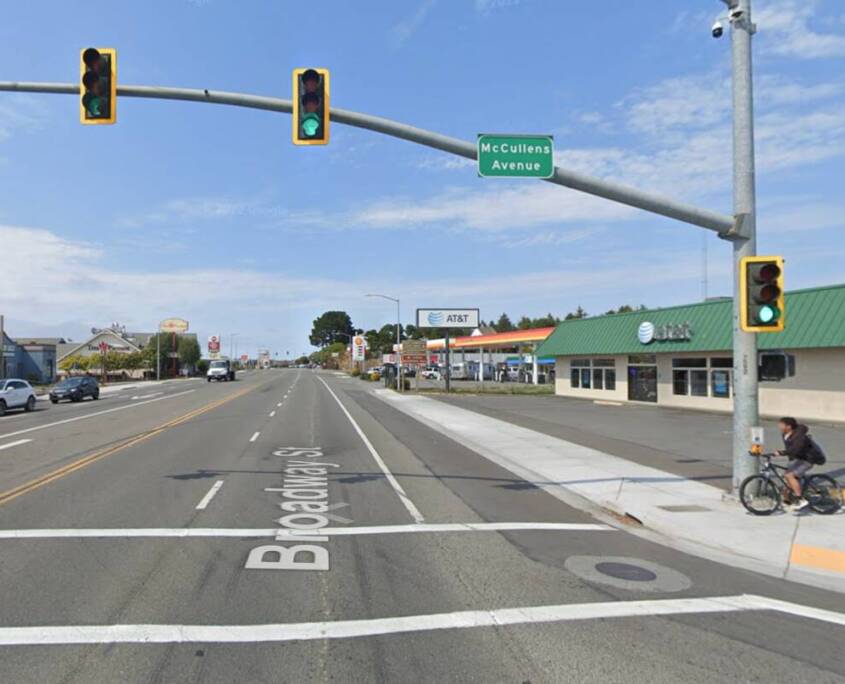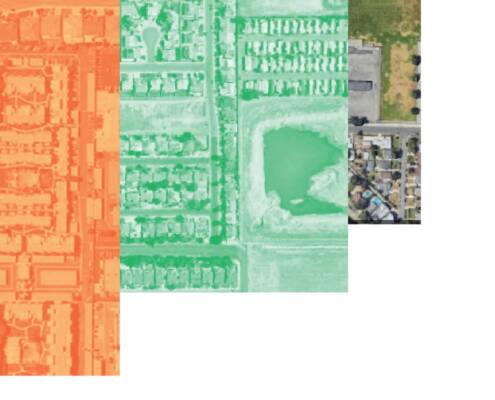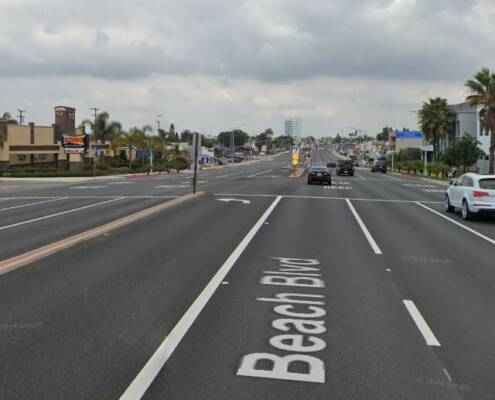We have to give Caltrans credit for doing a few projects solely for the benefit of pedestrians and bike riders — although, without pressure from CalBike and many other advocates across California, we might not have even these. However, even when Caltrans puts the focus on Complete Streets, it leaves out critical elements, which means it’s not actually creating a Complete Street.
In this installment, we look at a Complete Street project in Humboldt County as well as two other repaving projects that highlight the range of creative excuse-making from Caltrans project managers for excluding active transportation infrastructure from projects.
Caltrans does the right thing — sort of
Out of 569 project documents provided to CalBike by Caltrans in response to a 2023 public document request, 200 are on corridors where people are allowed to bike or walk and are programmed into the 2024 State Highway Operation and Protection Program (SHOPP). We had hoped to have a more comprehensive view of the 2024 SHOPP so we could fact-check Caltrans’ claim that it allocated $930 million to active transportation infrastructure. Unfortunately, Caltrans continues to stonewall the request we made in April for documents that would back up this claim, so we have to assume the 200 projects we see constitute the total universe of Complete Streets expenditures from that funding cycle.
The total expenditures Caltrans labels as Complete Streets elements — which include such items as signage, restriping existing crosswalks and bikeways, and non-optional ADA infrastructure — comes to just under $253 million. If there’s more, Caltrans either can’t or won’t show us.
Of the 200 projects in the 2024 SHOPP that identified bicycle or pedestrian needs, 112 appeared to include all recommended Complete Streets elements from the Complete Streets Decision Document (CSDD) in the final project, and at least five projects were entirely for bicycle and pedestrian infrastructure. So that’s good, right? Not always.
As we dug deeper into the documentation, we found that the recommended Complete Streets elements in the CSDDs didn’t always include all the desired safety improvements for people biking, walking, or taking transit. The Transportation Planning Scoping Information Sheet (TPSIS — apologies for the alphabet soup; it’s a hazard of reviewing too many project documents) included with each Project Initiation Document (PID) often details other needs that never make it into the CSDD.
Before we go to a specific example, one more note about Caltrans documentation: it’s confusing, self-contradictory, and just generally a mess. Imagine running an organization with forms and procedures, except each district does things its own way and different staffers within each office within the district also use the forms differently. Trying to make sense out of how that entity functions at an organizational level is an almost impossible challenge because it doesn’t function at an organizational level. Each Caltrans project appears to be its own fiefdom, ruled at the whim of the staffers in charge, with little oversight from district management, less oversight from headquarters, and no public oversight.
However, we can see that very little of the agency’s operations serve vulnerable road users.
What’s left out in a completely Complete Streets project
A 2024 SHOPP project on Highway 101 in Humboldt County is, in many ways, an example of Caltrans getting it right. Much of what’s right in this project has to do with advocacy from the Coalition for Responsible Transportation Priorities (CRTP), which led a strong local push for safer streets. Within the project area, Highway 101 becomes Broadway, a main thoroughfare through Eureka. It is part of the Pacific Coast Bike Route. Broadway is traveled by people using all transportation modes, but traffic speeds are high and there are no marked bikeways. The project creates a Class I shared bike/pedestrian path separated from traffic, which extends the active transportation network on the edge of town and connects bike riders to other bike routes.
Caltrans considered local and district active transportation plans and centered the needs of vulnerable road users in this project by creating the Class I path. In fact, the path was originally part of a much bigger complete streets project from the 2020 SHOPP, which adds Class IV separated bikeways, protected intersections, bus stop improvements, and traffic calming to a two-mile stretch of Broadway.
The Class I path was carved off and delayed four years to lower the cost of the bigger 2020 SHOPP project. The TPSIS for the 2024 project notes: “Careful coordination needs to be had with EA 01-0K940K South Broadway Complete Streets. This project currently proposes an interim solution of Class IV bikeways in this section, but the Class I shared use path proposed here is the long term solution.” In other words, bicyclists will have to make do with a few pieces of plastic separating them from highway-speed traffic until the Class I path is built.
Caltrans should be commended for developing significant Complete Streets projects on a dangerous state highway like Broadway. But the Class I path is one of approximately five 2024 SHOPP projects entirely focused on the needs of people biking and walking, and it’s only included in that SHOPP cycle because it was cut four years ago to save money. In contrast, 425 projects in the 2024 SHOPP are exclusively for the benefit of people using motor vehicles, and 175 projects are primarily for drivers but have some Complete Streets elements. It’s a clear statement of Caltrans’ priorities.
Excuses, excuses
One theme we’ve seen in reviewing Caltrans Complete Streets documentation is the creative excuses the agency comes up with to explain why it can’t provide infrastructure for people to safely ride a bike, walk, or take transit. In the two examples below, Caltrans pulls a huge number out of a hat to make shoulder widening to accommodate bike riders seem infeasible and develops a sudden need to protect the local flora when it’s time to build a bikeway.
A tale of two projects in District 8
On two-lane SR 62, a repaving project along 30 lane miles, east of Twentynine Palms, and another project on 24 lane miles farther east were both in the 2024 SHOPP. They had the same “Complete Streets” recommendations: standard paved shoulders, rumble strips, flying wedges. Neither ultimately included any elements protecting people biking and walking. The first justified this by saying the area is rural and there isn’t enough bicycle or pedestrian traffic to justify widening the shoulders. The second cited the high cost of shoulder widening.
Guess which shoulder would cost $9M and which would cost $48M
That’s where the differences between these two projects get interesting. The one east of Twentynine Palms estimated the cost of adding shoulders at $9,102,730, plus detailed estimates for the rumble strips and flying wedges. The project farther east estimated shoulder widening at “48 millions” and didn’t include any cost estimates for the other elements. Viewed on Google Maps’ aerial view, the terrain for both segments of roadway looks very similar: rural high desert with minor elevation change.
Engineers estimated that shoulders would cost almost five times as much on the project to the east, on a stretch of road three miles shorter than the western project, in similar terrain. While it appears that the team preparing the first CSDD at least bothered to develop realistic cost estimates, the second team threw down a highly inflated round number and used that as justification not to build bicycle infrastructure the district clearly never intended to include.
Caltrans speaks for the trees in District 11
A repaving project on 66.7 lane miles of 2-lane SR 79 near Julian in the 2022 SHOPP recommended five improvements for people biking and walking. Three were relatively inexpensive, ranging in price from $128 to $60,200 for pavement markings, share the road signs, and rumble strips. However, creating ten lane miles of Class II bikeways by widening shoulders would have cost $3.9 million and was excluded from the $26.5 million project. Details on pp. 107-109.
In the end, only about $100,000 out of $4 million in recommended active transportation infrastructure was included in the project. The pattern of choosing the cheapest recommended elements so Caltrans can say it did something for people who bike and walk, while excluding costlier elements that might provide real safety, was common among many of the project documents we reviewed.
The justification for not creating safer bikeways states, in part: “The areas that would benefit from shoulder widening to accommodate bicyclists have many issues that will increase the project costs, exceeding the projects’ allowable funding. The issues include the environmental cost of having to disturb possible sensitive vegetation such as trees and plants.” So we must ask: when has Caltrans ever nixed a highway widening project because it might disturb “sensitive vegetation such as trees and plants”? It is ironic that Caltrans balks at five or six feet of shoulder widening to give bike riders safe passage because of environmental concerns. This is further evidence that Caltrans staffers will use any excuse, no matter how far-fetched, when they simply don’t want to include bicycle infrastructure in a project.
Our next installment of Incomplete Streets will examine the ongoing fight to make El Camino Real in the Bay Area safer for people biking and walking. Our full report will be ready in August.
Kendra Ramsey and Laura McCamy from CalBike and Colin Fiske from the Coalition for Responsible Transportation Priorities contributed to this installment of Incomplete Streets. Published concurrently on Streetsblog California.










